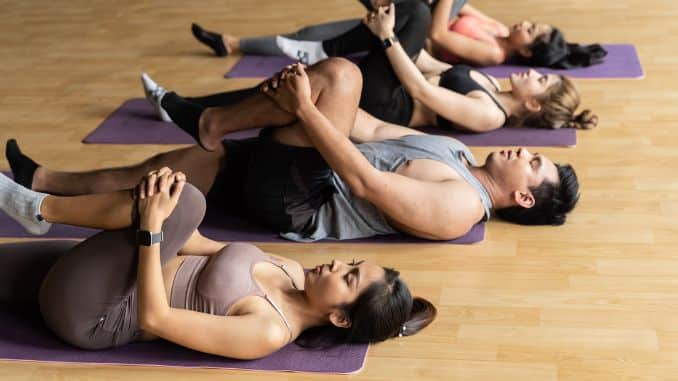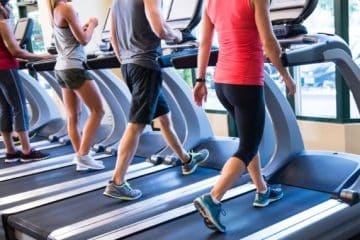In a world that often demands conformity and structure, there is something truly liberating about embracing the concept of free movement. This captivating form of yoga beckons us to break free from the rigid constraints of traditional yoga postures or asanas. Moreover, explore the limitless possibilities of our bodies in motion. Imagine a yoga practice with no rules and preconceived notions of how a pose should look or feel. Instead, Free Movement Yoga encourages us to be playful and trust our instincts on the yoga mat, just like children.
So get ready to embark on a transformative journey of self-expression.
The Concept Of Free Movement Yoga Poses
Free Movement Yoga is a unique approach to yoga that focuses on the freedom of the body and self-expression. Unlike traditional yoga styles that often involve holding static poses for a prolonged period, free movement yoga encourages practitioners to explore body forms and create their movements and poses according to their body’s needs and desires.
It's a practice that allows individuals to express themselves through their unique movement patterns rather than conforming to prescribed poses. Free movement yoga also allows individuals to tap into their intuition and connect with their bodies on a deeper level.
This concept of free movement yoga emphasizes playfulness with your movements, just like a child. Thus, it’s recommended to play like a kid during your practice every once in a while. It’s a liberating practice that promotes both physical and emotional well-being.
Benefits Of Free Movement Yoga Practice
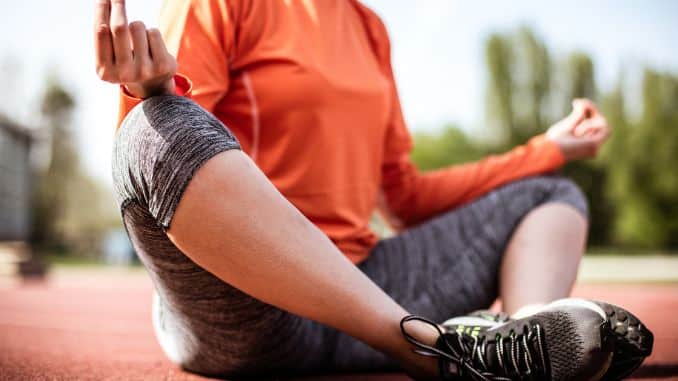
Practicing yoga has numerous benefits for the mind, body, and soul. By practicing Free movement yoga, individuals can experience improved flexibility, increased strength, and enhanced body awareness. The following are also its benefits:
-
Physical Benefits
Incorporating free movement into yoga can lead to a healthier, more balanced body. It improves muscle tone and reduces the risk of injury. Free movement yoga also helps improve posture and maintain alignment throughout, as it requires mindful awareness of the body’s movements. This leads to better spinal health and a reduction in back pain.
-
Mental Benefits
Free movement yoga routine is an effective tool for maintaining mental wellness and finding inner balance. It fosters a sense of empowerment. As individuals flow through various postures and movements, they can release tension and stress from the body, which promotes mental relaxation and clarity.
-
Spiritual Benefits
Free movement yoga helps to release stagnant energy and emotions that may be blocking our spiritual growth. This form of yoga allows us to tap into our inner wisdom and connect with our higher selves. Also, it allows us to experience a sense of peace and harmony within ourselves and the world around us.
Basic Free Movement Yoga Poses
Yoga poses help to stretch and strengthen the body. Individuals can tune into the natural flow of energy within. From gentle flows to organic shapes, basic poses empower practitioners to explore intuitive movements, fluid transitions, and creative variations.
These poses also serve as gateways to discovering the joy of moving freely, unlocking the potential for self-discovery. Some of the basic yoga poses are listed below:
1. Cat-Cow Pose
This pose helps increase spinal flexibility and mobility.
2. Downward Facing Dog
It strengthens the upper torso while simultaneously stretching and lengthening the spine and hamstrings.
3. Child’s Pose
Achieve relaxation and a sense of comfort, and also relieve stress through Child's Pose.
4. Mountain Pose
Improve posture and alignment through Mountain Pose. Mountain Pose, also known as Tadasana, promotes postural alignment. This also cultivates a sense of calm and mental clarity by incorporating Mountain Pose into your practice.
5. Upward Facing Dog Pose (Urdhva Mukha Svanasana)
Strengthen your arms, shoulders, and core with the Upward Facing Dog Pose.
Improve your overall well-being by incorporating these poses into your routine.
Different Types Of Free Movement Yoga Poses And Routines
The combination of different types of poses in a free-movement yoga routine allows practitioners to create a well-rounded practice that addresses various aspects of physical and mental well-being.
One of the main categories of poses in free movement yoga is standing poses. These poses, such as the Warrior series or Tree pose, require balance and stability while engaging the muscles of the legs, core, and upper torso. Standing poses not only increases strength and flexibility but also helps improve posture and body awareness.
The Resting pose is another important aspect of free-movement yoga. These poses, such as Child's Pose or Savasana, are designed to relax the body and mind. Resting poses allow practitioners to release tension, reduce stress, and restore energy. They are also often incorporated in between more challenging poses to provide a moment of rest and rejuvenation.
Lastly, a balancing pose in yoga involves finding equilibrium and stability, both physically and mentally. These poses challenge the practitioner to engage their core muscles, enhance focus, and improve overall coordination and body awareness.

Various other poses make up a free-movement yoga routine. These can include:
1. Forward Fold
2. Backbend
3. Twist
4. Inversion
5. Chair Pose
6. Triangle Pose
Each pose has its own benefits and challenges, targeting different muscle groups and promoting overall flexibility and strength.
Free Movement Yoga Poses For Beginners
Incorporating beginner yoga poses into a daily yoga session can help beginners ease into the practice. These are just a few examples of the many yoga poses for beginners to explore and enjoy.
1. Knees To Chest
Lie on your back with your knees bent and your feet flat on the floor. Lift both knees towards your chest and hold onto your knees with both arms. Then, Look for a light stretch in your lower back, hips, and glutes. Engage your core. Gently rock your knees from side to side several times as you close your eyes and relax your face and belly. Then, relax and return to the starting position.
Move your knees in a circular motion from one direction to the other, or feel free to explore other movements your body allows.
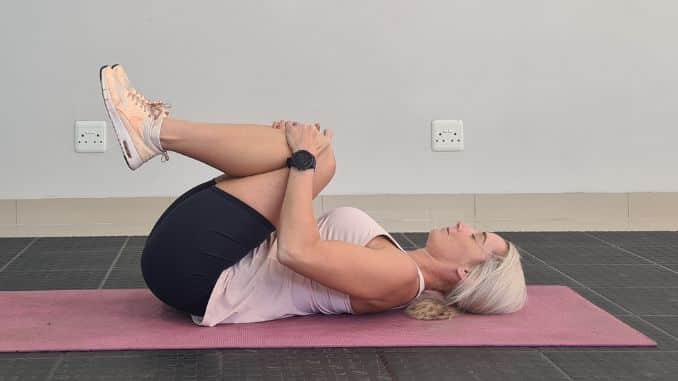
2. Hip Circles
Lie on your back with your knees bent and your feet flat on the floor. Bring both knees up towards your chest and hold onto your knees with each hand. Engage your core and spread your knees apart, then move each of your knees in a wide circular motion in opposite directions several times. Lastly, you can gently rock your hips from side to side or explore other free movements.
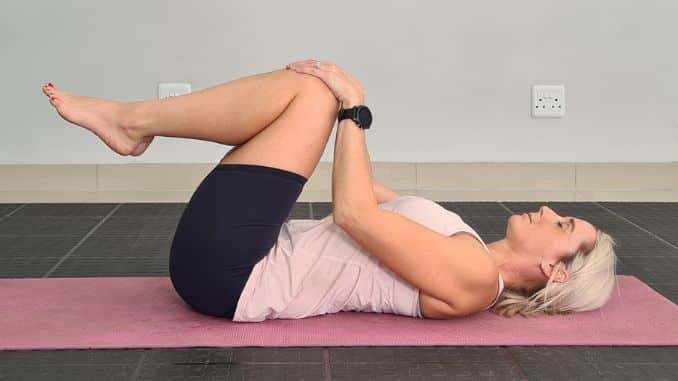 |
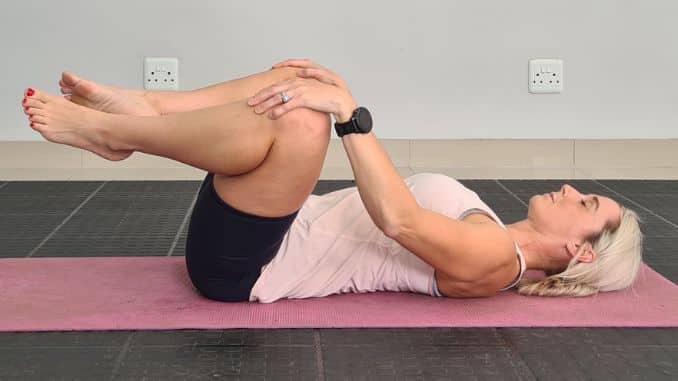 |
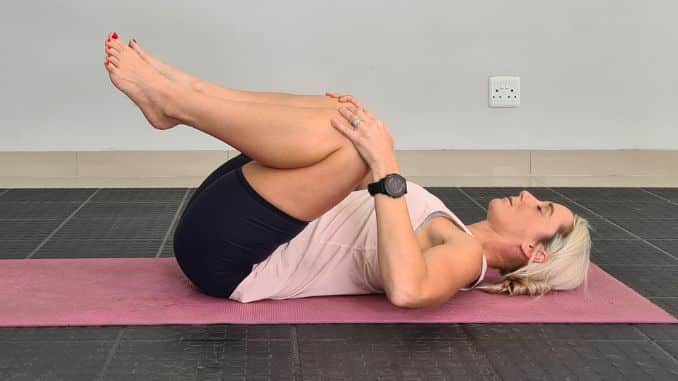 |
Hip circles
3. Happy Baby
Firstly, lie on your back on the floor with your knees bent and feet flat on the floor, relaxing your upper body. Secondly, lift your legs and hold your toes with each hand, pulling down toward the shoulders with your knees wide apart. Then, hold the position for several deep belly breaths, in through your nose and out through your mouth.
To intensify this exercise, you can gently rock your lower spine from side to side.
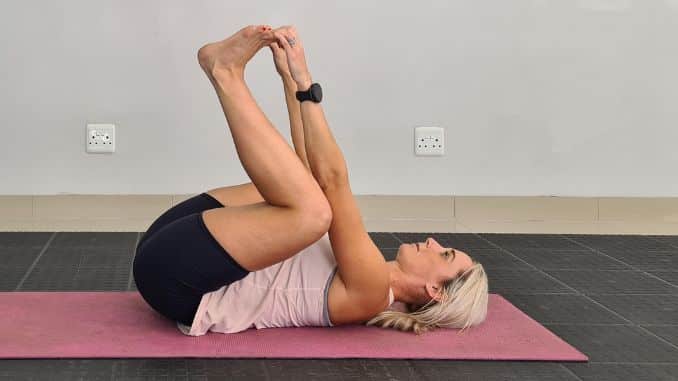
Happy Baby
-
Variation 1 – Happy Baby
Lie on your back on the floor with your knees bent and feet flat on the floor, relaxing your upper body. Then, Lift your legs and hold your toes with each hand, pulling down toward the shoulders with your knees wide apart. Hold the position for a couple of seconds, then slowly move your body to the side as you bring one knee down towards your chest while holding the opposite leg up. Lastly, repeat the movement alternately on the opposite side.
Feel free to play with your yoga movements to find out what feels good for you and what doesn’t.
You can march your feet in the air as if walking on the ceiling or alternately move each foot up and down as if you’re bicycling while keeping your hold on your big toes if you can.
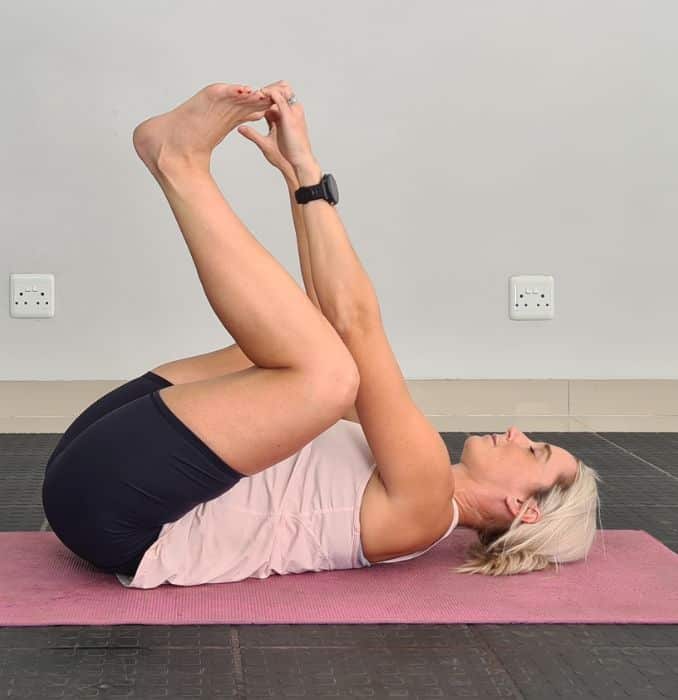 |
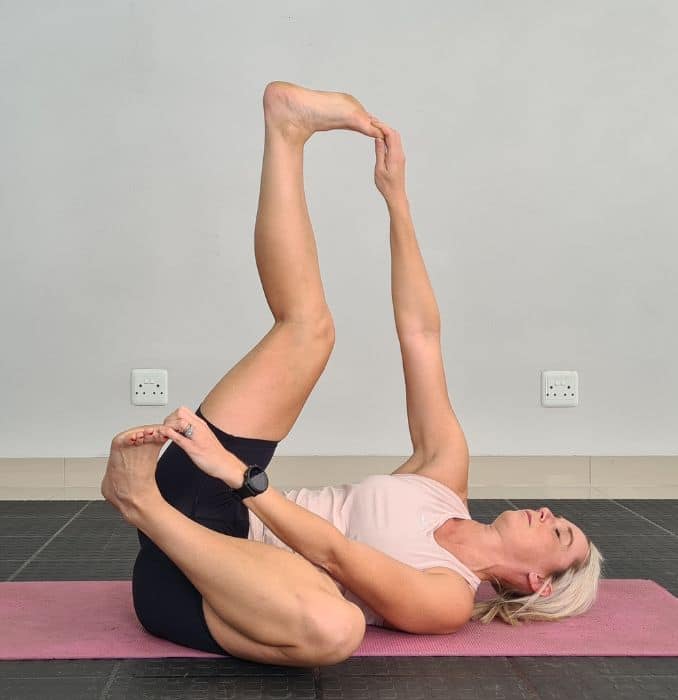 |
Variation 1 – Happy Baby
4 . Spinal Rocking
Lie on your back with your knees bent and feet flat on the floor. Then, tighten your core, slightly bend your knees, and raise both legs upward. Afterward, Place your hands at the back of your knees for support. Engage your core and, using your body’s momentum, raise your body into a sitting position, then move back down into the starting position. Finally, repeat the sequence of movements.
 |
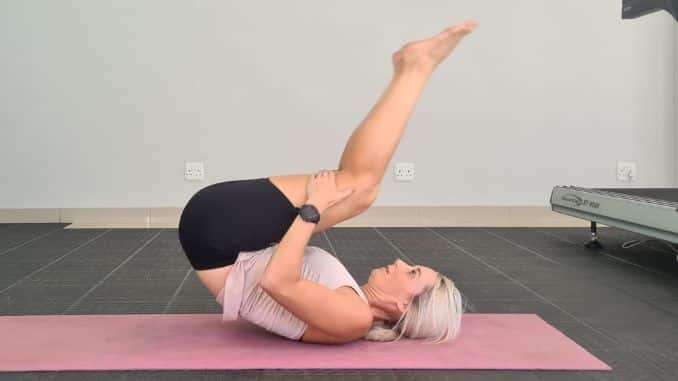 |
Spinal Rocking
5. Seated Neck And Back Stretch
Firstly, begin in an upright sitting position on the floor with your knees bent and your feet flat on the floor, maintaining good alignment with your head, shoulders, and hips. Secondly, lightly hug both knees with both hands. Thirdly, engage your core and lower your head forward as you move your chin closer to your chest and round out your back for a light stretch. Lastly, Hold the position for several deep belly breaths, in through your nose and out through your mouth.
To intensify the stretch, you can slowly turn your head to one side as you bend your neck, then dip your head forward
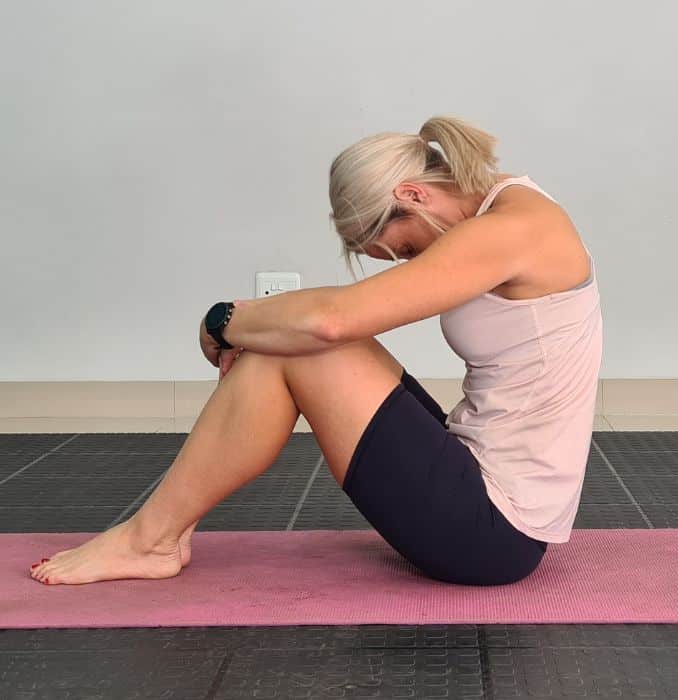
Seated Neck and Back Stretch
6. Windshield Wipers
Begin in an upright sitting position on the floor with your knees bent and your feet flat on the floor, wider than shoulder-width apart. Then, maintain good alignment in your upper body. Plant your palms on the floor behind for support as you slightly lean your upper body backward. After that, engage your core and alternately lower both knees from side to side. Lastly, repeat the movement several times.
For comfort or intensity variation, you can repeat the movements at a slower or faster pace or drop your knees a bit further on the floor.
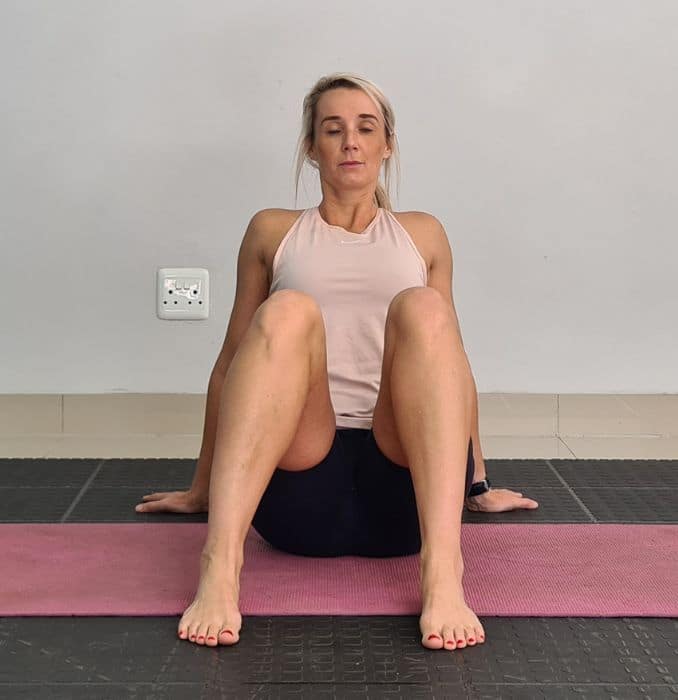 |
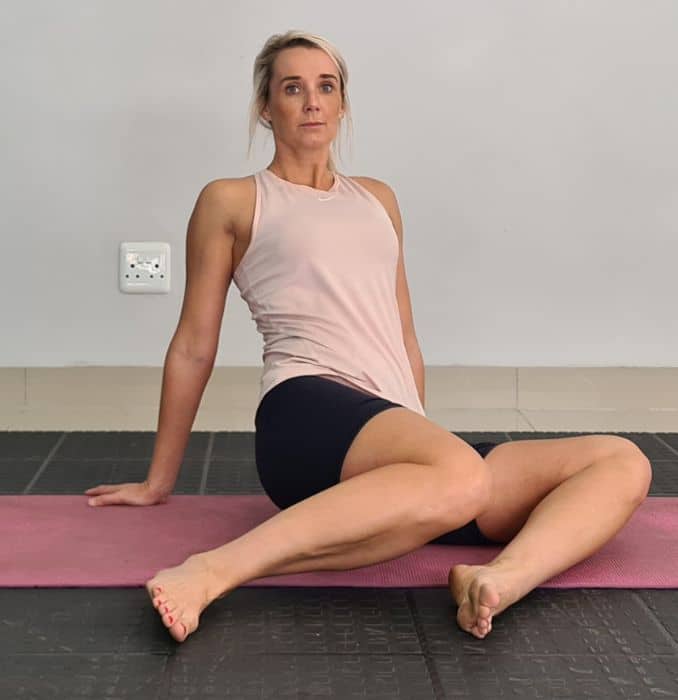 |
Windshield Wipers
7. Cat-Cow Pose
Firstly, begin in a 4-point position with your hands beneath your shoulders and your knees under your hips. Secondly, Inhale as you contract your abdominal area. Then exhale, slowly rounding your mid back as you lower your head downward. Afterward, alternate by lifting your head and arching your mid back. Then, hold each position for a couple of seconds. Lastly, Repeat the sequence of movements.
For this exercise, you may vary at a slower or faster pace.
 |
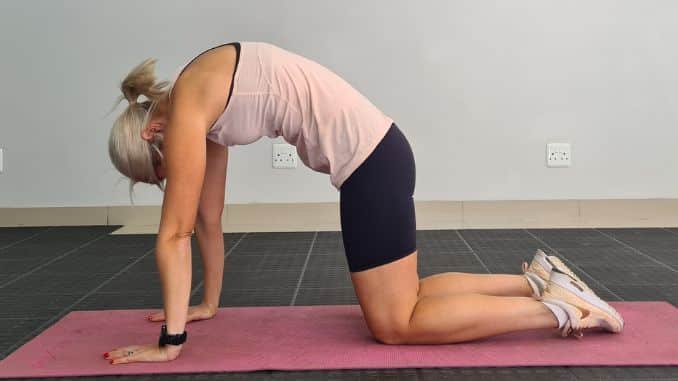 |
Cat-Cow
8. Disco Cow (Barrel Roll)
Begin in a 4-point position with your hands beneath your shoulders and your knees under your hips. Then, contract your abdominal area. Arch your mid back, then bend your upper body to one side. Roll to round your mid back out, then circle your upper body to bend on the opposite side. Afterward, repeat the sequence of movements several times. Lastly, perform the movement on the opposite side.
You can drop and shake your head or explore other Disco Cow-free yoga movements.
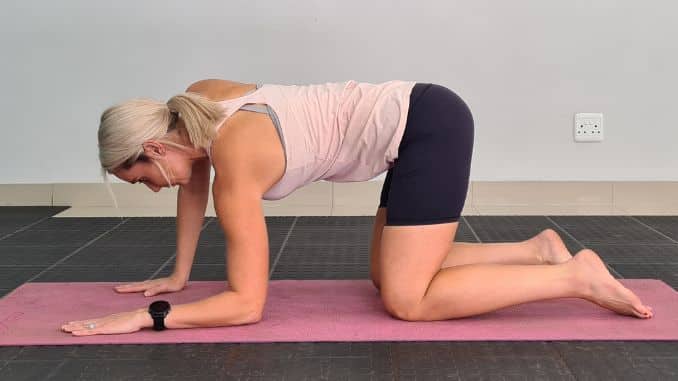 |
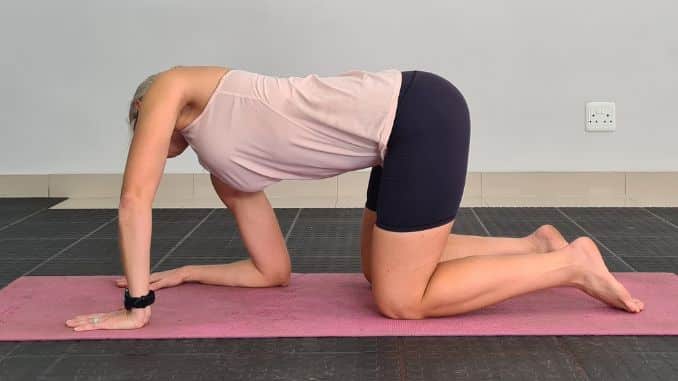 |
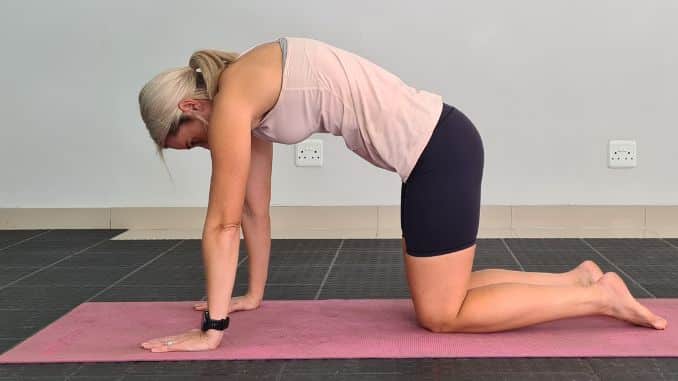 |
Disco Cow (Barrel Roll)
9. Tabletop With Side Reach
Begin in a 4-point position with your hands beneath your shoulders and your knees under your hips. Then, engage your core. Afterward, stretch your right hand to the left upper corner of the mat, slightly dropping your upper body and holding the position. Then, repeat the movement on the opposite side. Finally, relax and repeat the sequence of movements a few times.
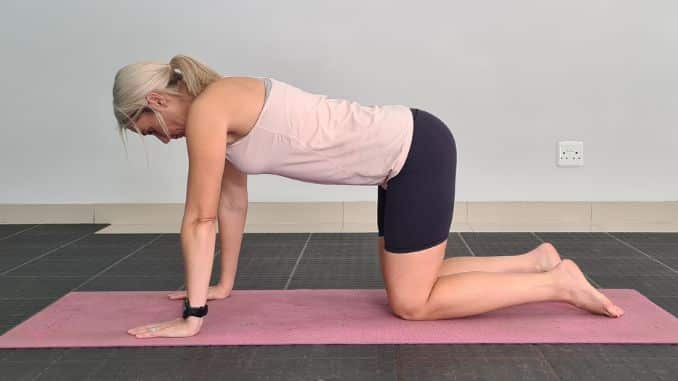 |
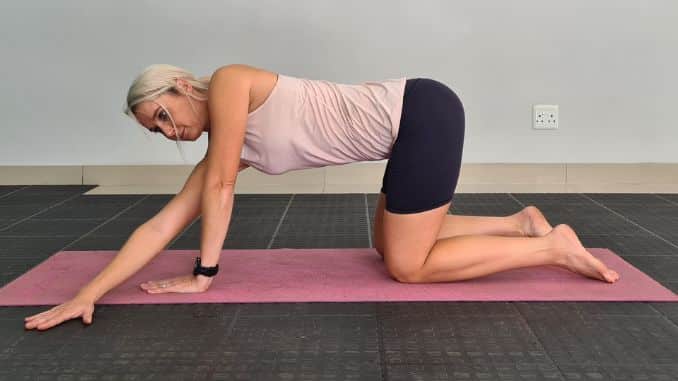 |
Tabletop With Side Reach
10. Child’s Pose
Firstly, begin in a 4-point position with your hands under your shoulders and your knees under your hips. Secondly, widen the distance between your knees and place your big toes together. Thirdly, Engage your core and inhale. Fourthly, exhale as you shift your hips back to your feet and extend your arms overhead. Then, inhale and return to the starting position. Lastly, repeat the sequence of movements several times at your own pace.
For another free movement variation, exhale as you shift your hips back to your feet and extend your arms overhead. Then, lower your forehead on the floor or stack your fists under your forehead and relax your mid-back area for a light stretch. Finally, take several deep belly breaths and return to the starting position.
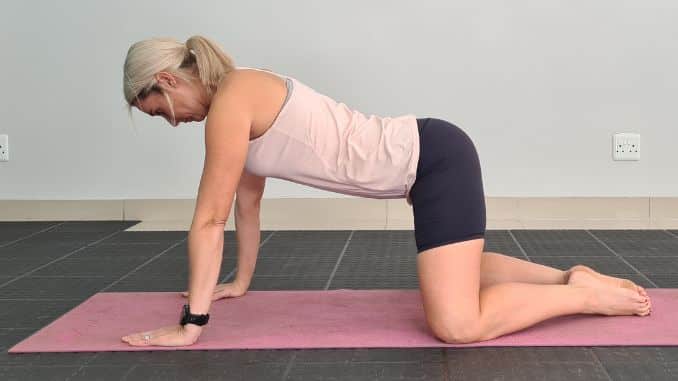 |
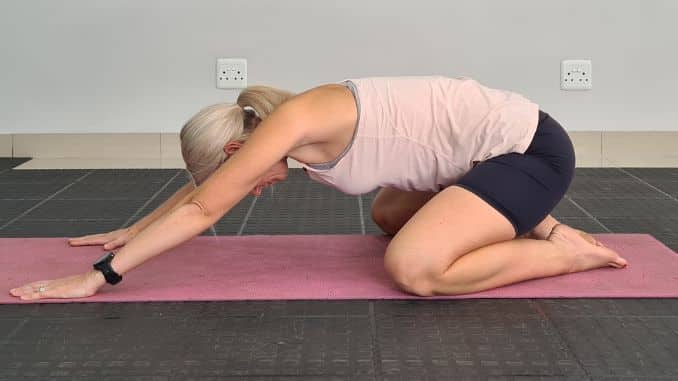 |
Child’s Pose
11. Thread The Needle
Firstly, begin in a 4-point kneeling position with your hands beneath your shoulders and your knees under your hips. Secondly, plant your right hand in the center. Thirdly, engage your core, inhale, and extend your left arm towards the ceiling, rotating your upper body to one side. Fourthly, exhale and thread your left arm through the gap between the right arm and the leg. Then, reach as far as your left arm can go. Afterward, hold this position for a few deep belly breaths. Then, repeat the movement several times at your own pace. Finally, return to the starting position and repeat the movement on the opposite side.
You can also rest the left side of your head on the floor and hold the position while keeping your right hand on the floor for support or placing it on your lower back.
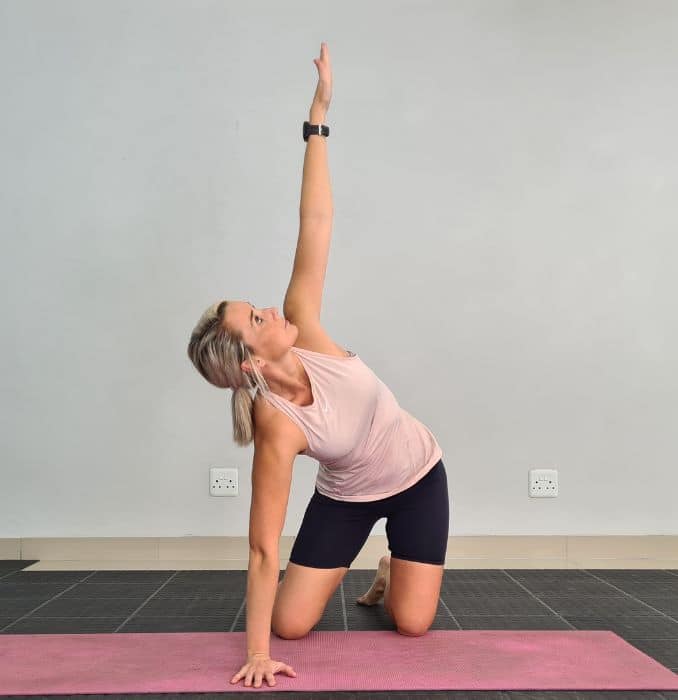 |
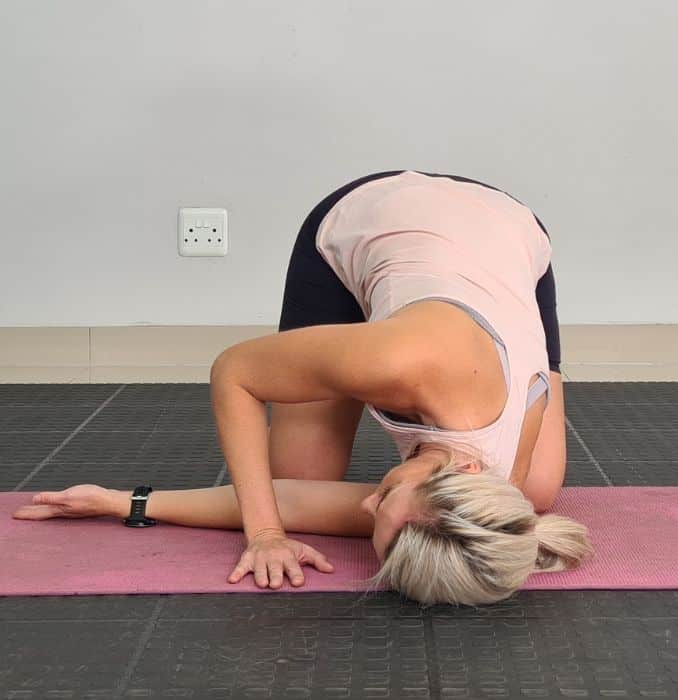 |
Thread the Needle
12. Bird Dog
Firstly, Begin in a 4-point position, with your hands underneath your shoulders and your knees underne=ath your hips. Then, maintain good alignment with your head, shoulders, and hips. Contract your abdominal area. Extend your left arm forward to be in line with your shoulder, then gently extend your opposite leg straight behind your body. Afterward, keep your left arm, shoulders, hips, and right leg parallel to the floor. Hold the position for a couple of seconds. Repeat the movement several times at your own pace. Then repeat the sequence of movements on the opposite side.
To make the movement more challenging, you bring your left hand and right foot to your back, tap your right foot, and inhale as you return to the parallel position.
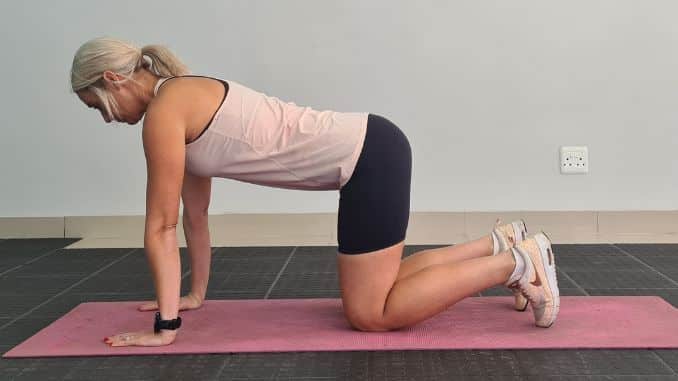 |
 |
Bird Dog
13. Overhead Reach
Firstly, begin in an upright sitting position on the floor with your legs crossed, maintaining good alignment with your head, shoulders, and hips. Secondly, engage your core, inhale, and reach one hand toward the ceiling. Thirdly, on your exhale, plant your left hand on the floor at your side, just beside your hip. Fourthly, inhale, and on your exhale, reach the right arm toward the opposite side as you bend your upper body towards your left. Then, repeat the sequence of the movement on the opposite side. Afterward, start with a few repetitions by going back and forth on each side at your own pace or rhythm.
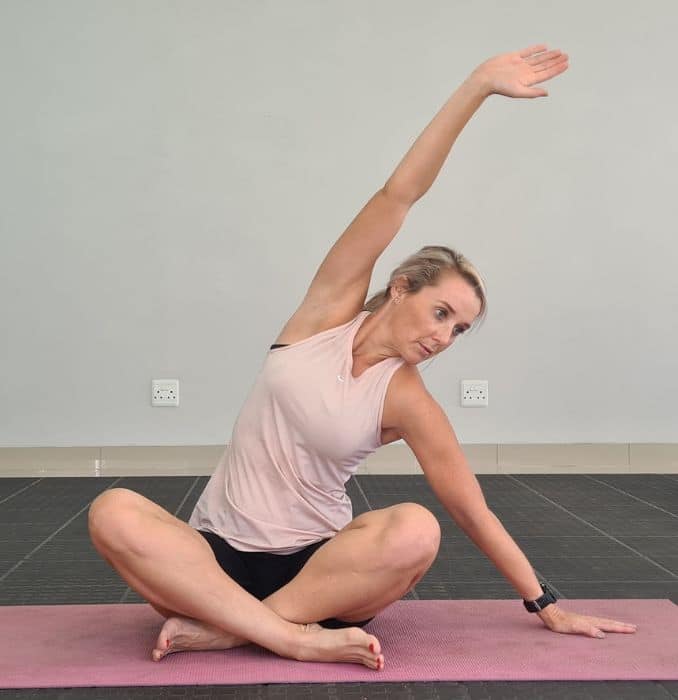
Overhead Reach
14. Breaths
Firstly, Begin in an upright sitting position on the floor with your legs crossed, maintaining good alignment with your head, shoulders, and hips. Inhale as you move both hands overhead, then place both hands together and move them down towards your heart center. Then, close your eyes and hold this prayer position for several deep belly breaths.
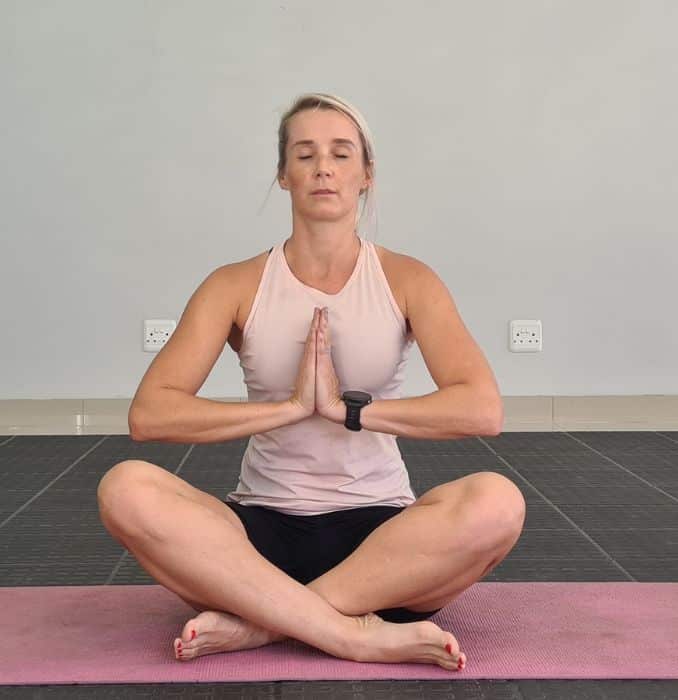
Breaths
More Advanced Poses
An advanced pose strengthens the core of the yogi while improving balance and focus.
Enhance your practice by starting with a few of our lists below:
1. Downward Facing Dog (Adho Mukha Svanasana) And Variations
The Downward Facing Dog is a foundational pose in yoga that is often used as a starting point for more advanced movements. This pose is great for stretching the entire body. Once you have mastered the traditional Downward Facing Dog, you can start exploring variations of the pose to add more challenge and variety to your practice.
Moreover, one variation is the Three-Legged Downward Facing Dog which helps strengthen the core and improve balance. Another variation is the Downward Facing Dog Twist, which helps open up the shoulders and improve spinal mobility.
Incorporating these variations into your practice certainly lets you experience a deeper stretch.
2. Free-Flow Tree Pose
Dynamic variations of the traditional Tree Pose encourage practitioners to explore the full range of motion in their bodies. Moreover, the free-flowing aspect promotes fluidity and grace. This liberated expression of Tree Pose nurtures a sense of creativity and self-expression. Yogis can indeed cultivate a deep sense of joy, freedom, and harmony through the free-flowing Tree Pose.
3. Grounded Flow
This practice encourages the release of physical tension and mental stress, helping to calm the nervous system and enhance overall relaxation. Through Grounded Flow Yoga, such as “Corpse Pose,” yogis can certainly experience a profound sense of stability, peace, and a deeper connection to their inner selves.
4. Wave-Like Spine
The wave-like motion helps a yogi find a rhythm that feels fluid and comfortable while doing the routine. Wave-like Spine Yoga can bring a profound sense of vitality, suppleness, and ease to the spine, leading to improved physical comfort.
5. Wheel Pose (Urdhva Dhanurasana)
Incorporating Wheel Pose into your practice can lead to improved flexibility, strength, emotional well-being, and an overall sense of expansion and joy.
6. Grasshopper Pose (Maksikanagasana)
This pose's deep hip opening and strengthening benefits make it a valuable addition to a well-rounded yoga exercise, providing physical and energetic benefits.
7. Dancing Shiva Pose (Natarajasana)
This advanced standing pose requires concentration and stability. The mental and physical discipline cultivated through the Dancing Shiva Pose can extend beyond your yoga practice.
8. Dolphin-Plank Pose (Makara Adho Mukha Svanasana)
Incorporating Dolphin Plank Pose into your practice can contribute to a stronger core, enhanced upper body strength, and improved overall stability and alignment.
9. Floating-Crow Pose (Eka Pada Bakasana)
One benefit of this pose is the development of core strength and balance. Floating Crow Pose challenges practitioners to cultivate mental focus and concentration, as it requires both physical and mental coordination to find balance and hold the pose.
10. Bridge Pose Free Flow Yoga
It strengthens the back, glutes, and hamstrings, promoting better posture. Bridge Pose opens and stretches the chest and shoulders, relieving tension.
Explore these dynamic movements and incorporate them into your practice to delve deeper into the realm of free-flow yoga.
Incorporating Free Movement Yoga Into Your Daily Life
By integrating short sessions of free-movement yoga throughout your day, you can break away from the constraints of a sedentary lifestyle, release physical and mental tension, and rejuvenate your energy.
Whether it’s a few minutes of stretching and flowing in the morning, spontaneous dance breaks during the day, or winding down with gentle movements in the evening, incorporating free movement yoga into your daily life fosters a greater sense of freedom, self-awareness, and vitality.
Tips For A Successful Free Movement Yoga
Here are some tips to keep in mind to ensure a successful free-movement yoga practice:
1. Accessories And Props
Choose the right accessory or props that support your body and align with your intentions for the practice. These tools can indeed enhance your experience and help you achieve a successful session. For example, using a yoga block or a balance ball can help you improve your balance and stability.
2. Incorporate Music
Music can enhance your free-movement yoga practice by creating an atmosphere that inspires and motivates you. Experiment with different genres, rhythms, and melodies that resonate with your energy and the movements you're exploring.
3. Warm Up: Awareness Of Breathing Exercises
Firstly, begin your practice with a gentle warm-up to prepare your body for movement. Incorporate flowing movements, stretches, and joint mobilization exercises to loosen up your muscles and increase circulation in your leg muscles and throughout your body. Connect your movements with your breath. Focus on slow, deep breathing throughout your practice, allowing the breath to guide and enhance your movements.
4. Create A Safe Space
Find a quiet and clutter-free area where you can move freely without any obstructions. And then, clear the space of any potential hazards and ensure you have enough room to stretch and explore different movements.
5. Listen To Your Body
Free movement yoga is about honoring your body's needs and intuition. Pay attention to how your body feels during each movement and adjust accordingly. Also, respect your limitations and avoid pushing yourself into uncomfortable or painful positions.
6. Explore Different Rhythms
Free movement yoga allows you to explore various rhythms, speeds, and tempos in your practice. Play with both slow and fast movements, fluid and dynamic transitions, and find the unique flow that resonates with you at the moment.
7. Express Yourself Creatively
Free movement yoga is indeed an opportunity for self-expression and creativity. Release any self-judgment or expectations and allow yourself to move authentically. You will also embrace the freedom to explore unconventional shapes, flows, and transitions that feel natural to you.
8. Stay Present, Mindful, And Enjoy The Journey
Keep your focus on the present moment as you flow through your movements. Then, let go of any distractions or thoughts outside of your practice. Also, cultivate mindfulness by bringing your attention to the sensations, breath, and movements as they arise.
FAQs
-
Where Can I find Free Movement Yoga class?
There are free movement yoga classes available online. Many studios now offer virtual classes with a certified yoga instructor that can be accessed from the comfort of your own home.
Also, you can search for “yoga class online” on a search engine, and you’ll find numerous websites and platforms that provide free movement yoga classes. Better yet, join our virtual community and embark on a transformative yoga journey from the comfort of your home.
Explore a variety of yoga classes suitable for all levels at our Gentle Stretching and Lifelong Wellness websites and Facebook page. These yoga classes may be in the form of pre-recorded videos or live-streamed sessions.
Enjoy a yoga class online and reap its benefits today.
-
What Are The Common Misconceptions About Free Movement Yoga?
Some of the common misconceptions about free-movement yoga are as follows:
-
- This practice is unstructured and lacks discipline.
- Free movement yoga is only for advanced practitioners.
- This practice is chaotic and lacks focus.
- Free movement yoga lacks alignment and supportive postures.
- This practice is not a legitimate form of yoga.
Conclusion: Embrace The Freedom In Your Yoga Practice
It’s vital to recognize the immense potential that lies within each and every one of us as we practice yoga.
Whether it’s through the exploration of different asanas, the incorporation of meditation and mindfulness, or simply listening to our bodies and honoring our own unique needs, free movement yoga posture offers a transformative journey of self-expression, creativity, and liberation.
Tap into the innate wisdom of your body and cultivate a deeper connection with yourself and the present moment by embracing the freedom to move intuitively and authentically. You can also, release the constraints of rigid structures, let go of expectations, and allow your asanas to become a personal expression of movement. So embrace the freedom, explore new possibilities, and discover the joy of moving freely on your yoga mat and throughout your life, starting today.
Moreover, in a world that often demands conformity and structure, there is something truly liberating about embracing the concept of free movement. This captivating form of yoga beckons us to break free from the rigid constraints of traditional yoga postures or asanas. Explore the limitless possibilities of our bodies in motion.
Imagine a yoga practice with no rules and preconceived notions of how a pose should look or feel. Instead, Free Movement Yoga encourages us to be playful and trust our instincts on the yoga mat, just like children.
So get ready to embark on a transformative journey of self-expression.
Get Forward Head Posture FIX today and say goodbye to text neck, back pain, and ugly posture for good!

